2006 SUBARU IMPREZA child seat
[x] Cancel search: child seatPage 66 of 365
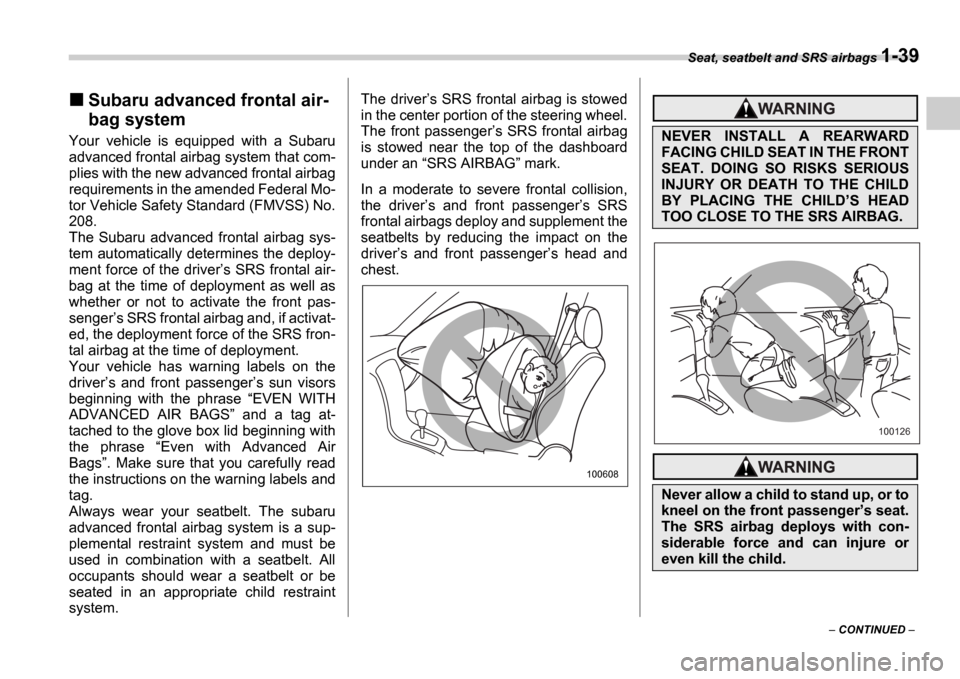
Seat, seatbelt and SRS airbags 1-39
CONTINUED
Subaru advanced frontal air-
bag system
Your vehicle is equipped with a Subaru
advanced frontal airbag system that com-
plies with the new advanced frontal airbag
requirements in the amended Federal Mo-
tor Vehicle Safety Standard (FMVSS) No.
208.
The Subaru advanced frontal airbag sys-
tem automatically determines the deploy-
ment force of the driver s SRS frontal air-
bag at the time of deployment as well as
whether or not to activate the front pas-
senger s SRS frontal airbag and, if activat-
ed, the deployment force of the SRS fron-
tal airbag at the time of deployment.
Your vehicle has warning labels on the
driver s and front passenger s sun visors
beginning with the phrase EVEN WITH
ADVANCED AIR BAGS and a tag at-
tached to the glove box lid beginning with
the phrase Even with Advanced Air
Bags . Make sure that you carefully read
the instructions on the warning labels and
tag.
Always wear your seatbelt. The subaru
advanced frontal airbag system is a sup-
plemental restraint system and must be
used in combination with a seatbelt. All
occupants should wear a seatbelt or be
seated in an appropriate child restraint
system. The driver
s SRS frontal airbag is stowed
in the center portion of the steering wheel.
The front passenger s SRS frontal airbag
is stowed near the top of the dashboard
under an SRS AIRBAG mark.
In a moderate to severe frontal collision,
the driver s and front passenger s SRS
frontal airbags deploy and supplement the
seatbelts by reducing the impact on the
driver s and front passenger s head and
chest.
100608
NEVER INSTALL A REARWARD
FACING CHILD SEAT IN THE FRONT
SEAT. DOING SO RISKS SERIOUS
INJURY OR DEATH TO THE CHILD
BY PLACING THE CHILD S HEAD
TOO CLOSE TO THE SRS AIRBAG.
Never allow a child to stand up, or to
kneel on the front passenger s seat.
The SRS airbag deploys with con-
siderable force and can injure or
even kill the child.
100126
Page 67 of 365
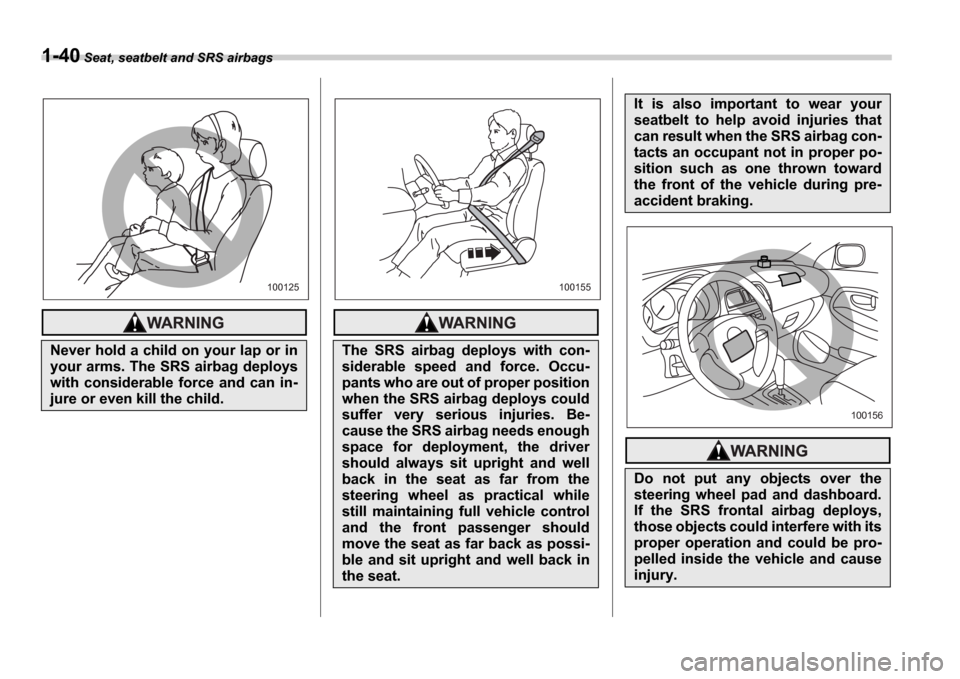
1-40 Seat, seatbelt and SRS airbags
Never hold a child on your lap or in
your arms. The SRS airbag deploys
with considerable force and can in-
jure or even kill the child.
100125
The SRS airbag deploys with con-
siderable speed and force. Occu-
pants who are out of proper position
when the SRS airbag deploys could
suffer very serious injuries. Be-
cause the SRS airbag needs enough
space for deployment, the driver
should always sit upright and well
back in the seat as far from the
steering wheel as practical while
still maintaining full vehicle control
and the front passenger should
move the seat as far back as possi-
ble and sit upright and well back in
the seat.
100155
It is also important to wear your
seatbelt to help avoid injuries that
can result when the SRS airbag con-
tacts an occupant not in proper po-
sition such as one thrown toward
the front of the vehicle during pre-
accident braking.
Do not put any objects over the
steering wheel pad and dashboard.
If the SRS frontal airbag deploys,
those objects could interfere with its
proper operation and could be pro-
pelled inside the vehicle and cause
injury.
100156
Page 69 of 365
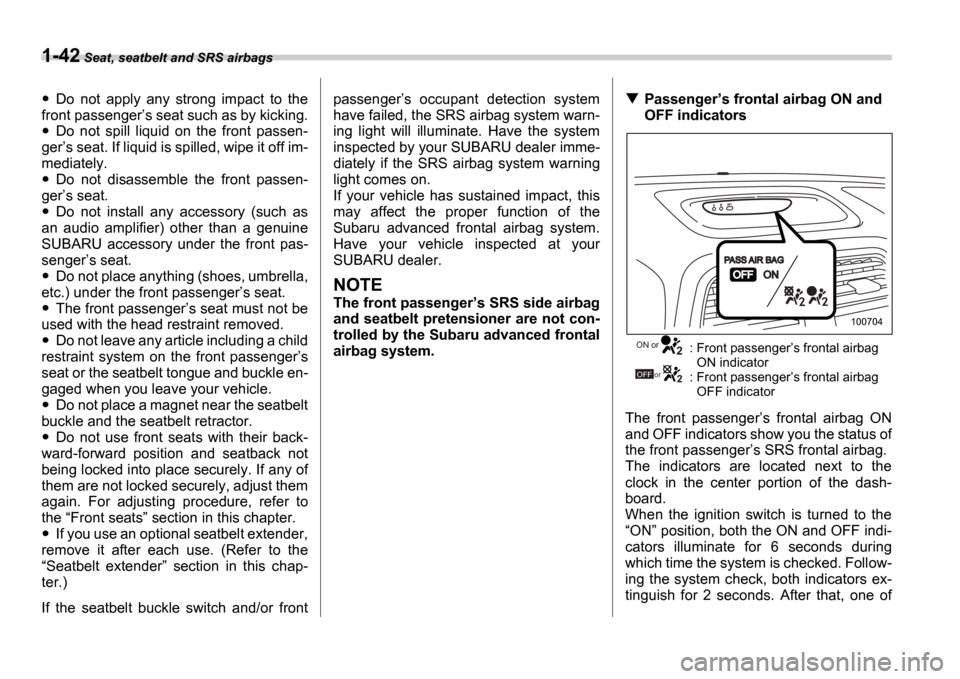
1-42 Seat, seatbelt and SRS airbags
Do not apply any strong impact to the
front passenger s seat such as by kicking.
Do not spill liquid on the front passen-
ger s seat. If liquid is spilled, wipe it off im-
mediately.
Do not disassemble the front passen-
ger s seat.
Do not install any accessory (such as
an audio amplifier) other than a genuine
SUBARU accessory under the front pas-
senger s seat.
Do not place anything (shoes, umbrella,
etc.) under the front passenger s seat.
The front passenger s seat must not be
used with the head restraint removed.
Do not leave any article including a child
restraint system on the front passenger s
seat or the seatbelt tongue and buckle en-
gaged when you leave your vehicle.
Do not place a magnet near the seatbelt
buckle and the seatbelt retractor.
Do not use front seats with their back-
ward-forward position and seatback not
being locked into place securely. If any of
them are not locked securely, adjust them
again. For adjusting procedure, refer to
the Front seats section in this chapter.
If you use an optional seatbelt extender,
remove it after each use. (Refer to the Seatbelt extender section in this chap-
ter.)
If the seatbelt buckle switch and/or front passenger
s occupant detection system
have failed, the SRS airbag system warn-
ing light will illuminate. Have the system
inspected by your SUBARU dealer imme-
diately if the SRS airbag system warning
light comes on.
If your vehicle has sustained impact, this
may affect the proper function of the
Subaru advanced frontal airbag system.
Have your vehicle inspected at your
SUBARU dealer.
NOTE
The front passenger s SRS side airbag
and seatbelt pretensioner are not con-
trolled by the Subaru advanced frontal
airbag system.
Passenger s frontal airbag ON and
OFF indicators
: Front passenger s frontal airbag
ON indicator
: Front passenger s frontal airbag
OFF indicator
The front passenger s frontal airbag ON
and OFF indicators show you the status of
the front passenger s SRS frontal airbag.
The indicators are located next to the
clock in the center portion of the dash-
board.
When the ignition switch is turned to the ON position, both the ON and OFF indi-
cators illuminate for 6 seconds during
which time the system is checked. Follow-
ing the system check, both indicators ex-
tinguish for 2 seconds. After that, one of
100704
ON or
OFF or
Page 70 of 365
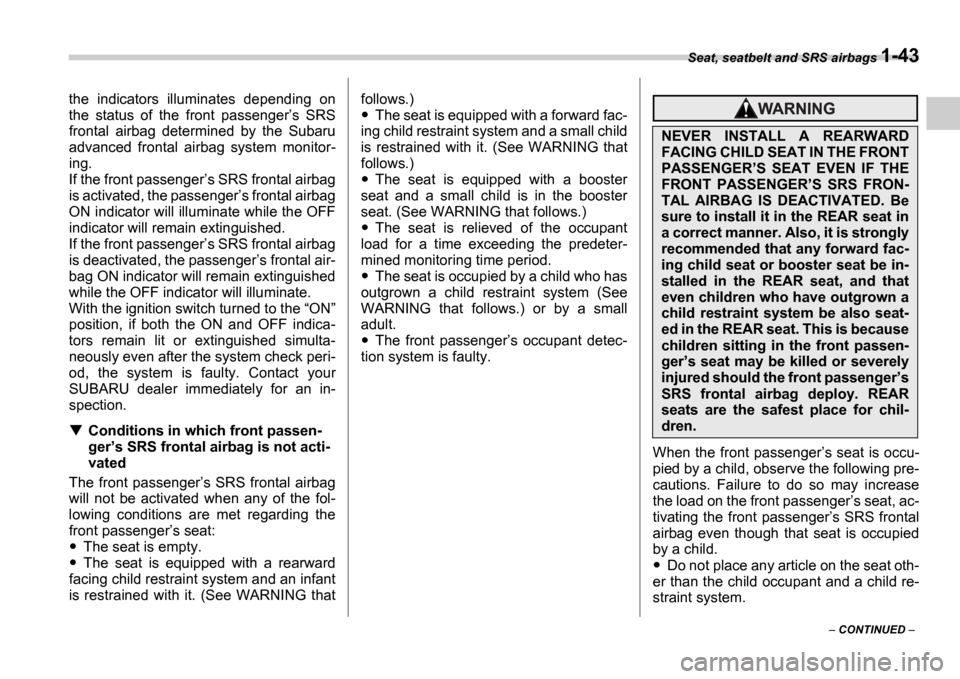
Seat, seatbelt and SRS airbags 1-43
CONTINUED
the indicators illuminates depending on
the status of the front passenger
s SRS
frontal airbag determined by the Subaru
advanced frontal airbag system monitor-
ing.
If the front passenger s SRS frontal airbag
is activated, the passenger s frontal airbag
ON indicator will illuminate while the OFF
indicator will remain extinguished.
If the front passenger s SRS frontal airbag
is deactivated, the passenger s frontal air-
bag ON indicator will remain extinguished
while the OFF indicator will illuminate.
With the ignition switch turned to the ON
position, if both the ON and OFF indica-
tors remain lit or extinguished simulta-
neously even after the system check peri-
od, the system is faulty. Contact your
SUBARU dealer immediately for an in-
spection.
Conditions in which front passen-
ger s SRS frontal airbag is not acti-
vated
The front passenger s SRS frontal airbag
will not be activated when any of the fol-
lowing conditions are met regarding the
front passenger s seat:
The seat is empty.
The seat is equipped with a rearward
facing child restraint system and an infant
is restrained with it. (See WARNING that follows.)
The seat is equipped with a forward fac-
ing child restraint system and a small child
is restrained with it. (See WARNING that
follows.)
The seat is equipped with a booster
seat and a small child is in the booster
seat. (See WARNING that follows.)
The seat is relieved of the occupant
load for a time exceeding the predeter-
mined monitoring time period.
The seat is occupied by a child who has
outgrown a child restraint system (See
WARNING that follows.) or by a small
adult.
The front passenger s occupant detec-
tion system is faulty.
When the front passenger s seat is occu-
pied by a child, observe the following pre-
cautions. Failure to do so may increase
the load on the front passenger s seat, ac-
tivating the front passenger s SRS frontal
airbag even though that seat is occupied
by a child.
Do not place any article on the seat oth-
er than the child occupant and a child re-
straint system.
NEVER INSTALL A REARWARD
FACING CHILD SEAT IN THE FRONT
PASSENGER S SEAT EVEN IF THE
FRONT PASSENGER S SRS FRON-
TAL AIRBAG IS DEACTIVATED. Be
sure to install it in the REAR seat in
a correct manner. Also, it is strongly
recommended that any forward fac-
ing child seat or booster seat be in-
stalled in the REAR seat, and that
even children who have outgrown a
child restraint system be also seat-
ed in the REAR seat. This is because
children sitting in the front passen-
ger s seat may be killed or severely
injured should the front passenger s
SRS frontal airbag deploy. REAR
seats are the safest place for chil-
dren.
Page 71 of 365

1-44 Seat, seatbelt and SRS airbags
Do not place more than one child on the
seat.
Do not install any accessory such as a
table or TV onto the seatback.
Do not store a heavy load in the seat-
back pocket.
Do not allow the rear seat occupant to
place his/her hands or legs on the front
passenger s seatback, or allow him/her to
pull the seatback.
If the front passenger s frontal air-
bag ON indicator illuminates and the
OFF indicator extinguishes even
when an infant or a small child is in
a child restraint system (including
booster seat)
Turn the ignition switch to the OFF posi-
tion if the front passenger s frontal airbag
ON indicator illuminates and the OFF indi-
cator extinguishes even when an infant or
a small child is in a child restraint system
(including booster seat). Remove the child
restraint system from the seat. By refer-
ring to the child restraint manufacturer s
recommendations as well as the child re-
straint system installation procedures in
the Seat heater (if equipped) section in
this chapter, correctly install the child re-
straint system. Turn the ignition switch to
the ON position and make sure that the
front passenger s frontal airbag ON indi- cator goes out and the OFF indicator
comes on.
If still the ON indicator remains illuminated
while the OFF indicator extinguishes, take
the following actions.
Ensure that no article is placed on the
seat other than the child restraint system
and the child occupant.
Ensure that there is no article left in the
seatback pocket.
Ensure that the backward-forward posi-
tion and seatback of front passenger s
seat are locked into place securely by
moving the seat back and forth.
If the ON indicator still illuminates while
the OFF indicator extinguishes after tak-
ing relevant corrective actions described
above, relocate the child restraint system
to the rear seat and immediately contact
your SUBARU dealer for an inspection.
NOTE
When a child who has outgrown a child
restraint system or a small adult is
seated in the front passenger s seat,
the Subaru advanced frontal airbag
system may or may not activate the
front passenger s SRS frontal airbag
depending on the occupant s seating
posture. If the front passenger s SRS
frontal airbag is activated (the ON indi- cator illuminates while the OFF indica-
tor extinguishes), take the following
actions.
Ensure that no article is placed on
the seat other than the occupant.
Ensure that there is no article left in
the seatback pocket.
If the ON indicator still illuminates
while the OFF indicator extinguishes
despite the fact that the actions noted
above have been taken, seat the child/
small adult in the rear seat and immedi-
ately contact your SUBARU dealer for
an inspection. Even if the system has
passed the dealer inspection, it is rec-
ommended that on subsequent trips
the child/small adult always take the
rear seat.
Children who have outgrown a child re-
straint system should always wear the
seatbelt irrespective of whether the airbag
is deactivated or activated.
Conditions in which front passen-
ger s SRS frontal airbag is activated
The front passenger s SRS frontal airbag
will be activated for deployment upon im-
pact when any of the following conditions
is met regarding the front passenger s
seat.
When the seat is occupied by an adult.
Page 79 of 365
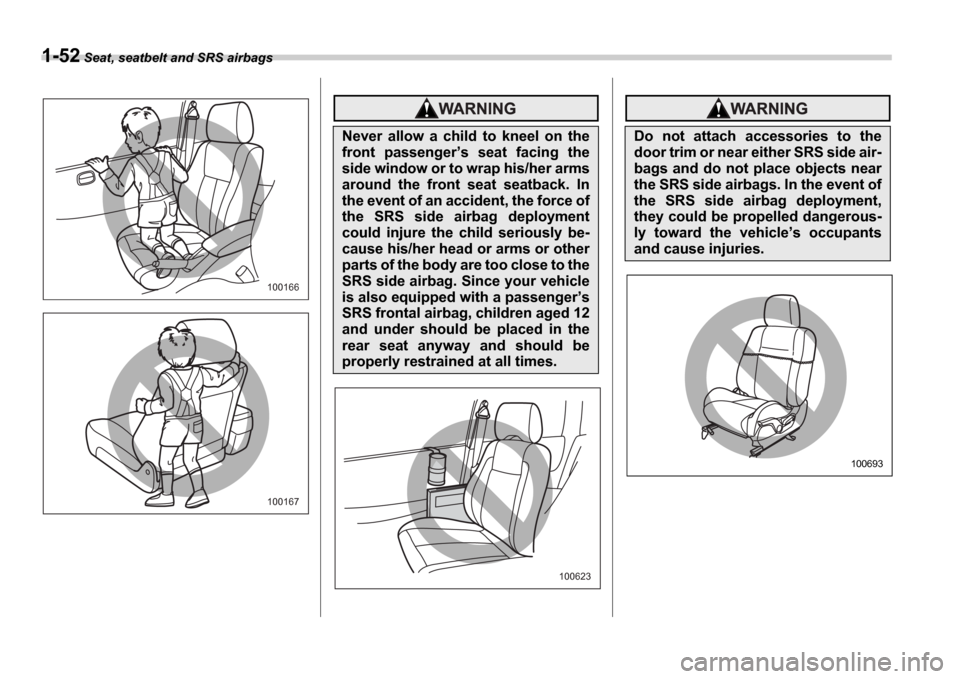
1-52 Seat, seatbelt and SRS airbags
100166
100167
Never allow a child to kneel on the
front passenger s seat facing the
side window or to wrap his/her arms
around the front seat seatback. In
the event of an accident, the force of
the SRS side airbag deployment
could injure the child seriously be-
cause his/her head or arms or other
parts of the body are too close to the
SRS side airbag. Since your vehicle
is also equipped with a passenger s
SRS frontal airbag, children aged 12
and under should be placed in the
rear seat anyway and should be
properly restrained at all times.
100623
Do not attach accessories to the
door trim or near either SRS side air-
bags and do not place objects near
the SRS side airbags. In the event of
the SRS side airbag deployment,
they could be propelled dangerous-
ly toward the vehicle s occupants
and cause injuries.
100693
Page 92 of 365
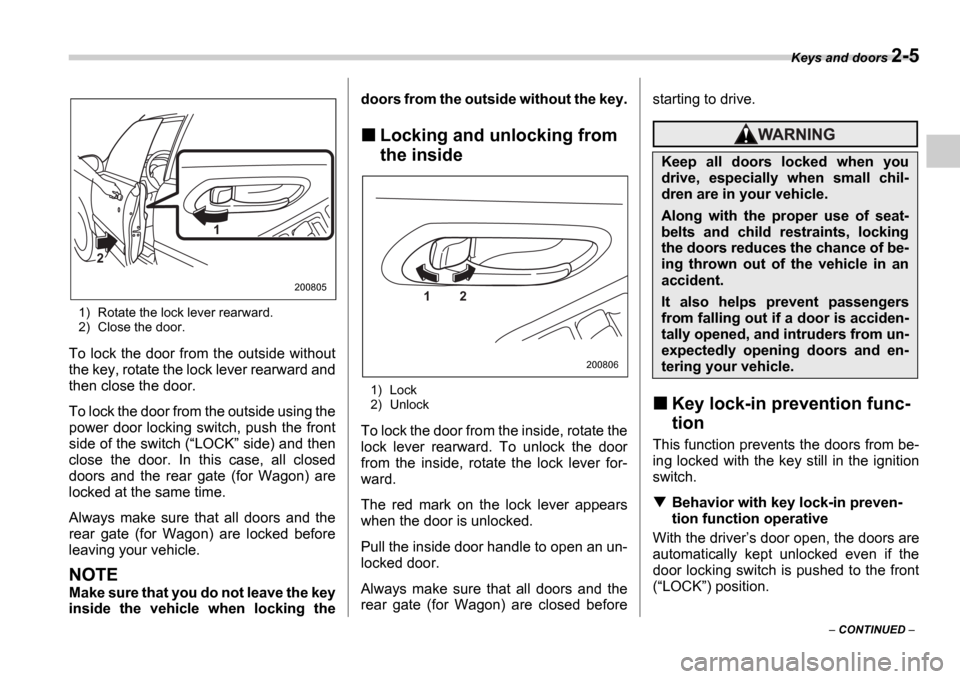
Keys and doors 2-5
CONTINUED
1) Rotate the lock lever rearward.
2) Close the door.
To lock the door from the outside without
the key, rotate the lock lever rearward and
then close the door.
To lock the door from the outside using the
power door locking switch, push the front
side of the switch ( LOCK side) and then
close the door. In this case, all closed
doors and the rear gate (for Wagon) are
locked at the same time.
Always make sure that all doors and the
rear gate (for Wagon) are locked before
leaving your vehicle.
NOTE
Make sure that you do not leave the key
inside the vehicle when locking the doors from the outside without the key.
Locking and unlocking from
the inside
1) Lock
2) Unlock
To lock the door from the inside, rotate the
lock lever rearward. To unlock the door
from the inside, rotate the lock lever for-
ward.
The red mark on the lock lever appears
when the door is unlocked.
Pull the inside door handle to open an un-
locked door.
Always make sure that all doors and the
rear gate (for Wagon) are closed before starting to drive.
Key lock-in prevention func-
tion
This function prevents the doors from be-
ing locked with the key still in the ignition
switch.
Behavior with key lock-in preven-
tion function operative
With the driver s door open, the doors are
automatically kept unlocked even if the
door locking switch is pushed to the front( LOCK ) position.
1
2
2008051 2
200806
Keep all doors locked when you
drive, especially when small chil-
dren are in your vehicle.
Along with the proper use of seat-
belts and child restraints, locking
the doors reduces the chance of be-
ing thrown out of the vehicle in an
accident.
It also helps prevent passengers
from falling out if a door is acciden-
tally opened, and intruders from un-
expectedly opening doors and en-
tering your vehicle.
Page 105 of 365
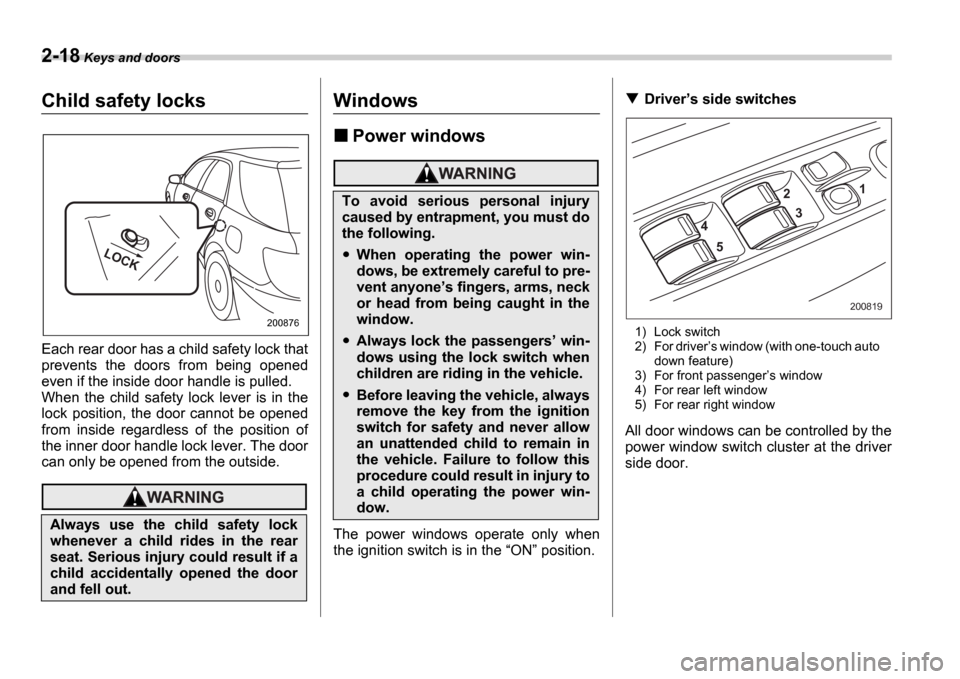
2-18 Keys and doors
Child safety locks
Each rear door has a child safety lock that
prevents the doors from being opened
even if the inside door handle is pulled.
When the child safety lock lever is in the
lock position, the door cannot be opened
from inside regardless of the position of
the inner door handle lock lever. The door
can only be opened from the outside.
Windows
Power windows
The power windows operate only when
the ignition switch is in the ON position.
Driver s side switches
1) Lock switch
2) For driver s window (with one-touch auto
down feature)
3) For front passenger s window
4) For rear left window
5) For rear right window
All door windows can be controlled by the
power window switch cluster at the driver
side door.
Always use the child safety lock
whenever a child rides in the rear
seat. Serious injury could result if a
child accidentally opened the door
and fell out.
L O CK
200876
To avoid serious personal injury
caused by entrapment, you must do
the following.
When operating the power win-
dows, be extremely careful to pre-
vent anyone
s fingers, arms, neck
or head from being caught in the
window.
Always lock the passengers win-
dows using the lock switch when
children are riding in the vehicle.
Before leaving the vehicle, always
remove the key from the ignition
switch for safety and never allow
an unattended child to remain in
the vehicle. Failure to follow this
procedure could result in injury to
a child operating the power win-
dow.
1
2
4 5 3
200819